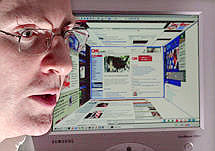By Bill Bergstrom
AP Business Writer
KING OF PRUSSIA, Pa. — Impatient with current Internet browsers, architect Mike Rosen figured he could make data-handling easier by adding a new dimension.
 |
| Mike Rosen's CubicEye browser lets a user see five Web pages at a time, displayed as if on the inside walls of a cube.
Associated Press |
So he developed the CubicEye browser, which displays five Web pages at a time, as if on the inside walls of a cube. The user can instantly interact with any of the pages.
Users don't have to navigate from page to page in linear fashion, Rosen explained has he took the CubicEye for a spin in the offices of 2ce Inc., of which he is chief executive. They can just flip the cube to a page that's already opened.
Pages on the cube's walls, ceiling and floor are not fully legible but are live and the user can see changes and click on prominent features. The page directly in front can zoom to full-screen size for detailed or extended work.
"Now I'm rotating between six sites,'' Rosen said. "So I'm reading six newspapers at one time. And I'm interacting with all these newspapers. And when I want to read it real carefully, I'm just going to zoom in all the way and read it like a regular browser.''
Pretty cool. But other than the fun of giving it a whirl, can Rosen convince experts the cube is useful?
Rosen, who has created virtual reality renderings of architectural designs and developed a virtual tour of the city of Philadelphia, envisions the 3D browser as part of a transition to a virtual reality-oriented approach to the Web, similar to the leap from text to windowed and graphically-enhanced computing.
Some experts doubt ordinary computer users want such an evolutionary step, and Rosen says 2ce's browser is aimed mainly at "power users'' who operate with many Web pages open at a time and need a structure to organize "the information overload.''
"It's pretty cool,'' said Mel Baiada, president and chief executive officer of Sengen, a Mount Laurel, N.J., software company. "It's a good way to keep track of related information. It's nice to have the other panels being updated in real time.''
Baiada, who is on the board of technology-oriented Drexel University, doesn't use the CubicEye himself. "I don't browse the Web that much,'' he said, but he sees uses for people needing to assemble data quickly.
"Say if you are a telephone operator trying to track down problems with a phone line. The main account information could come up on the main page, billing information on another panel and the history of problems on another. Rather than waiting and downloading it everything could come up at the same time,'' Baiada said.
Neal Goldman, an analyst with Yankee Group in Boston, thinks the novelty may backfire for some.
"Most people who experience virtual reality for the first time experience disorientation,'' he said.
Rosen said the design of the browser, which works in conjunction with Microsoft's Internet Explorer, feels familiar and can simplify computer use.
Opening cubes on the sides of cubes can multiply the possible pages by hundreds. Cubes can be saved for regular use, arraying shopping sites to find the best deal on a desired item, combining news pages in an information cube, or displaying several financial sites for a quick survey of markets.
"Literally this could be set up as a mall. Each one of these pages could be a different store. Or you can be chatting with three people and browsing the Internet on the other screens,'' Rosen said. Or reading six online newspapers.
Sound dizzying?
How about this: Rosen promises couch-potato paradise with another potential capability, possible by combining the technology with cable television: Watching five games at once.
Paul Sonderegger, an analyst for Forrester Research Inc. in Cambridge, Mass., said users may balk at manipulating cubes.
"It may be a misapplied metaphor, the idea that because people are familiar with a room, they will be comfortable with getting information off the walls, ceiling and floor,'' he said.
Chris Le Tocq, an analyst with the Gartner Group, said computers need to get simpler not more complicated.
Even with current browsers, Le Tocq said, "There is too much knowledge assumed by the designers. We've got a long, long way to go to get a user interface right. Both Microsoft and Apple could be doing a lot more work than they are.''
Regardless, Rosen said visitors to 2ce's Web site have been downloading up to a copy a minute of a beta version of CubicEye.
Rosen showed a demonstration version of the browser at the Comdex show in Las Vegas last November and was headed for Los Angeles to show it at the March 12-16 Internet World conference.
[back to top] |

